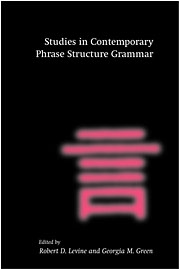Book contents
- Frontmatter
- Contents
- Introduction
- 1 The lexical integrity of Japanese causatives
- 2 A syntax and semantics for purposive adjuncts in HPSG
- 3 On lexicalist treatments of Japanese causatives
- 4 “Modal flip” and partial verb phrase fronting in German
- 5 A lexical comment on a syntactic topic
- 6 Agreement and the syntax–morphology interface in HPSG
- 7 Partial VP and split NP topicalization in German: an HPSG analysis
- Index
7 - Partial VP and split NP topicalization in German: an HPSG analysis
Published online by Cambridge University Press: 16 December 2009
- Frontmatter
- Contents
- Introduction
- 1 The lexical integrity of Japanese causatives
- 2 A syntax and semantics for purposive adjuncts in HPSG
- 3 On lexicalist treatments of Japanese causatives
- 4 “Modal flip” and partial verb phrase fronting in German
- 5 A lexical comment on a syntactic topic
- 6 Agreement and the syntax–morphology interface in HPSG
- 7 Partial VP and split NP topicalization in German: an HPSG analysis
- Index
Summary
Introduction
In previous work (Hinrichs and Nakazawa 1989, 1993, 1994, forthcoming) we have presented an HPSG analysis of German VP structure that crucially relies on the notion of argument composition. The scope of that analysis was essentially restricted to those clause types which place the finite verb in sentence-final position. The purpose of this paper is to present an analysis for the remaining clause types of German, specifically for assertion main clauses. This requires an account of the two syntactic phenomena that characterize assertion main clauses: 1. an account of topicalization which places a single constituent in sentence-initial constituent, and 2. an account of the so-called v2-position of the finite verb, which follows the topicalized constituent.
The treatment of these two phenomena builds on recent work of Pollard (1990) and Nerbonne (1994), although it differs considerably in scope and detail. We will follow Pollard's head nonmovement analysis of the finite verb in V2-position. However, we will depart from Pollard's account when it comes to topicalization. Pollard allows any combination of flat structure and hierarchical structure among verb-complement structures in order to be able to account for cases in which verbal constituents are topicalized with some of their NP arguments while others remain in situ. By Pollard's own admission, the resulting analysis has the undesirable property of introducing spurious ambiguity on a massive scale. Instead, our account of topicalization will follow the program begun by Nerbonne (1994).
- Type
- Chapter
- Information
- Studies in Contemporary Phrase Structure Grammar , pp. 275 - 332Publisher: Cambridge University PressPrint publication year: 2000
- 1
- Cited by



